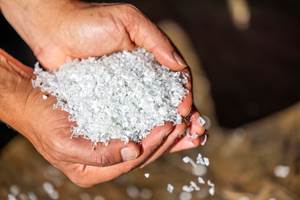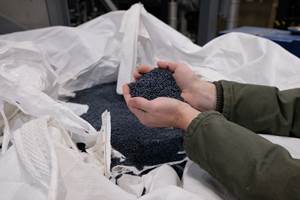'Green' and Growing
AERT (Advanced Environmental Recycling Technologies) Inc. in Springdale, Ark., maker of ChoiceDek wood/plastic composite deck boards, has always had a “green” strategy.
AERT (Advanced Environmental Recycling Technologies) Inc. in Springdale, Ark., maker of ChoiceDek wood/plastic composite deck boards, has always had a “green” strategy. Since it was founded in 1988, its goal has been to turn recycled wood and polyethylene into the highest quality deck boards available anywhere. The company struggled for the first 12 years to get its unusual cold-flow extrusion process to make money. Now with recent moves toward greater efficiency, automation, and economy of scale, AERT is becoming a low-cost producer.
Founder Joe Brooks developed the patented process to ensure 100% encapsulation of wood fiber with plastic before extrusion, which prevents delamination and other problems later. AERT blends recycled wood fiber (much of it from the local furniture industry) with recycled LDPE, LLDPE, and HDPE from film and gable-top milk and juice cartons. After about 1 hr of intensive mixing at 430 F in sequenced batch mixers, the hot plasticated material is sized into 2- to 4-in. chunks and discharged onto a belt to cool before being fed into chilled extruders with heated dies and embossers.
AERT buys only used single-screw extruders and then rebuilds them to its specifications with circulating chilled water and no heater bands. “When boards are cold formed, they have more strength,” says senior v.p. Alford Drinkwater.
Mixing and extrusion is now fully automatic, computerized and monitored from a control room on a different floor from manufacturing. There are no operators at the machines. But as production has grown over the past five years, AERT has doubled its work force to over 600 people.
Green and out of the red
AERT has been profitable since 2001 and steadily expanding. A new decking extrusion plant is ramping up production now, which will double AERT’s capacity. The new plant will have four more cold extrusion lines for a total of eight. The first new line is already running.
To reduce floor space for cooling the profiles, AERT devised an accumulator, which occupies a fraction of the floor space taken up by the network of horizontal conveyors in the original plant.
Last year, AERT launched MoistureShield, a new premium decking with deep colors and deep embossing, marketed directly to outlets serving professional contractors. MoistureShield is intended to diversify AERT’s product offerings and reduce its dependence on ChoiceDek, made for Weyerhaeser and distributed through Lowe’s, which is about 90% of AERT’s sales. AERT chairman Brooks says it also plans to introduce an “all-natural, chemical-free” cedar composite deck board next year.
Last year AERT used 125 million lb of recycled PE and the same amount of recycled wood fiber. AERT is adding a third plastic recycling plant and a new process to recycle lower grade film in the form of bags sourced from municipal recycling facilities. AERT plans to invest $45 million over the next five years in a new chopping, washing, and extrusion plant in Oklahoma with initial capacity to reclaim about 75 million lb/yr of bag film. AERT has also developed and filed for patents on new processes to optimize the melt index and density of the recycled bag material.
AERT already has two proprietary recycling processes, one for relatively clean post-consumer and post-industrial LLDPE film, the other to extract LDPE from wet paper pulp left after fiber is recovered from gable-top cartons. Clean film recycling involves grinding, dry separation of contaminants and metal, and then densifying before extrusion. AERT found it needed more rugged and powerful densifiers than those on the market, so the company designed its own and had them custom-built locally. Automatic controls sound a warning if temperature, amperage, or vibration exceeds preset limits.
AERT also built a new wood-fiber processing plant next to the new cold extrusion facility. AERT tests incoming wood fiber for moisture and particle size, grinds it, classifies it by size, then dries and classifies it again. The large rotary dryer is fired by waste wood from the process instead of the natural gas used in AERT’s original fiber plant—a further cost-saving and “green” improvement.
Related Content
Foam-Core Multilayer Blow Molding: How It’s Done
Learn here how to take advantage of new lightweighting and recycle utilization opportunities in consumer packaging, thanks to a collaboration of leaders in microcellular foaming and multilayer head design.
Read MoreRevalyu Breaks Ground on PET Recycling Facility in Georgia
Company expects new facility will be capable of chemically recycling 200 million pounds of post consumer PET per year.
Read MoreNew Facility Refreshes Post-Consumer PP by Washing Out Additives, Contaminants
PureCycle prepares to scale up its novel solvent recycling approach as new facility nears completion.
Read MoreIgus Unveils World’s “First” Urban Bike Made from Recycled Plastic
The engineering concept and key components for bikes made of recycled plastic are available to all bike manufacturers.
Read MoreRead Next
Processor Turns to AI to Help Keep Machines Humming
At captive processor McConkey, a new generation of artificial intelligence models, highlighted by ChatGPT, is helping it wade through the shortage of skilled labor and keep its production lines churning out good parts.
Read MoreWhy (and What) You Need to Dry
Other than polyolefins, almost every other polymer exhibits some level of polarity and therefore can absorb a certain amount of moisture from the atmosphere. Here’s a look at some of these materials, and what needs to be done to dry them.
Read MoreHow Polymer Melts in Single-Screw Extruders
Understanding how polymer melts in a single-screw extruder could help you optimize your screw design to eliminate defect-causing solid polymer fragments.
Read More

























